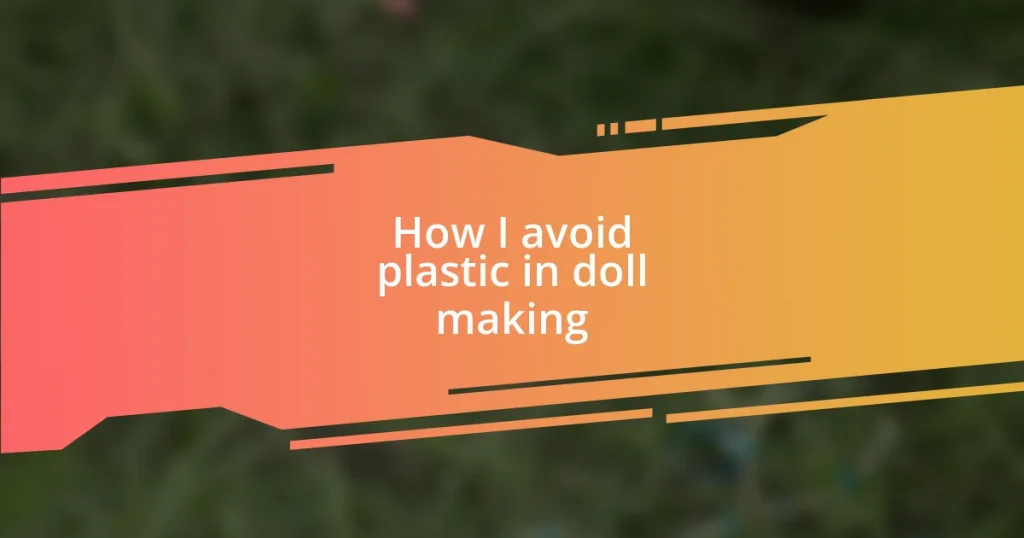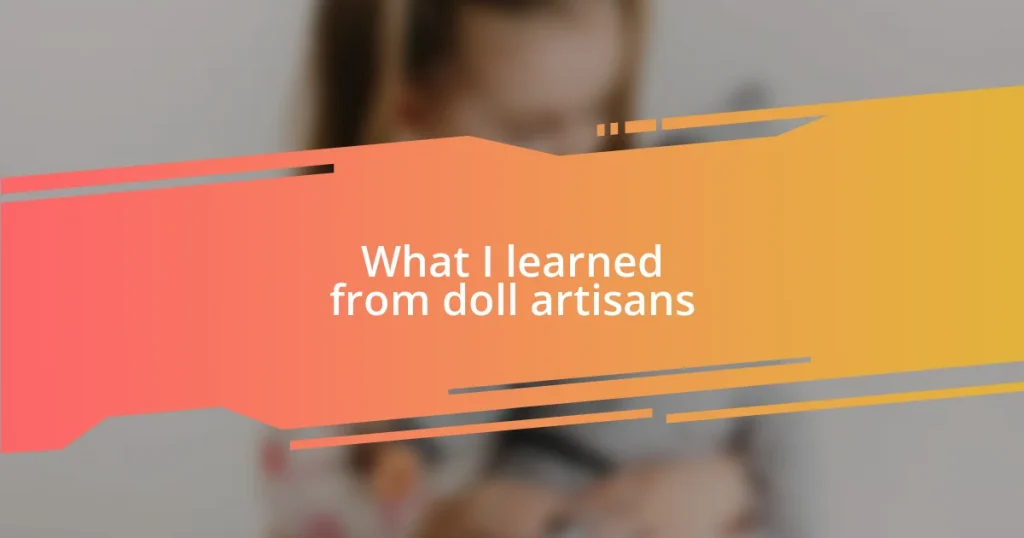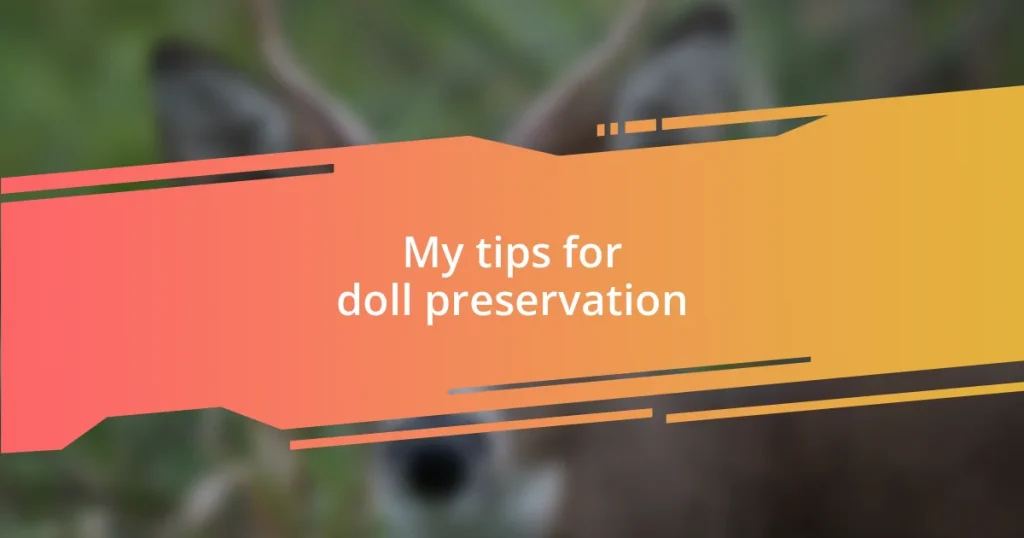Key takeaways:
- Plastic in doll-making poses environmental concerns, prompting a search for sustainable alternatives that offer both creativity and connection to nature.
- Natural materials such as wool, cotton, wood, and recycled paper facilitate environmentally friendly doll-making while enhancing the dolls’ warmth and character.
- Repurposing everyday objects and personal items adds uniqueness and sentiment to dolls, transforming discarded materials into cherished creations.

Understanding plastic in dolls
Plastic plays a significant role in doll-making, often shaping both the aesthetics and durability of the toys. When I first started crafting dolls, I was amazed by how many different types of plastics were used, each serving a distinct purpose—from soft PVC for limbs to rigid polystyrene for heads. Have you ever considered how these materials affect the overall experience of play?
As I dove deeper into my craft, I began to realize that while plastic offers flexibility and vibrant colors, it also brings environmental concerns that can’t be ignored. I vividly remember the moment I opened a brand-new doll pack only to be overwhelmed by the plastic packaging it came in. It made me think: is the joy of giving a doll worth the environmental impact we’re leaving behind with all this waste?
When I talk to fellow doll-makers, a common sentiment arises—many of us wish to embrace alternatives. There’s an emotional connection to our creations that plastic can often overshadow. It’s this tug-of-war between convenience and sustainability that keeps me invested in exploring innovative materials. What alternatives could we use to create beautiful, lasting dolls while caring for our planet?

Alternative materials for doll making
As I ventured into the world of doll-making without plastic, I discovered a range of alternative materials that not only preserve the integrity of my creations but also spark creativity. For instance, I’ve found that using natural fibers, like wool or cotton, adds a warm, huggable quality to the dolls that plastic simply can’t replicate. Each time I sculpt a doll with natural materials, it feels like I’m connecting my craftsmanship with the essence of nature itself.
Here are some incredible alternatives that I’ve explored:
- Wool: Soft and biodegradable, perfect for plush bodies.
- Cotton fabric: Versatile and available in countless prints, ideal for clothing and skin.
- Wood: Durable and aesthetically pleasing for limbs and facial features.
- Recycled paper or cardboard: Resourceful and creative for lightweight doll construction.
- Clay: Air-dry or polymer options fine for heads and accessories.
Switching to these materials not only reduces plastic waste but also allows me to craft dolls that tell a story—ones filled with warmth and character.
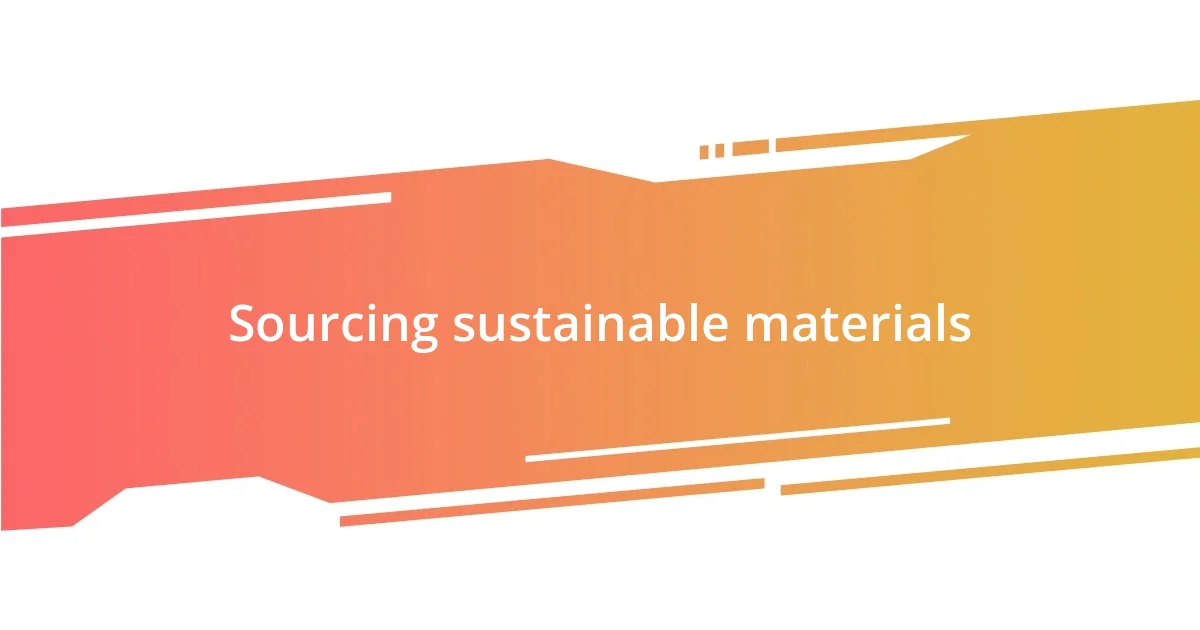
Sourcing sustainable materials
Sourcing sustainable materials often feels like embarking on a treasure hunt. I’ve spent countless weekends visiting local craft stores and exploring craft fairs, seeking out those precious materials that align with my eco-conscious goals. Each discovery, whether it’s a roll of organic cotton or ethically sourced wood, brings an undeniable thrill. It’s not just about avoiding plastics but about finding materials that resonate with the values I hold dear.
Comparing different materials has also helped me make informed decisions. When I tried using bamboo fabric instead of synthetic blends, I was amazed at how much softer and breathable it was for my doll creations. It was a game-changer for the doll’s outfits—my creations felt more alive. Have you ever touched a fabric that just felt right? That’s the kind of experience I hope to instill in the children who play with my dolls.
While there’s a learning curve, the journey to sourcing sustainable materials has become one full of rewarding moments. Each successful project reinforces my belief that sustainability can go hand in hand with creativity. I find joy in knowing that every doll I make carries a piece of my commitment to our environment, while also celebrating the beauty of natural materials.
| Material | Benefits |
|---|---|
| Bamboo | Soft, breathable, and biodegradable |
| Organic Cotton | Non-toxic, durable, and available in many colors |
| Wool | Natural insulation, soft feel for heads and bodies |
| Wood | Sturdy, non-toxic, and aesthetically appealing |
| Recycled Paper | Lightweight, resourceful; reduces waste |

Techniques for plastic-free dolls
One technique I’ve embraced is using felted wool for doll features. When I first experimented with needle felting, I was captivated by how easily soft fibers transformed into expressive faces. It’s almost magical—seeing how a simple poke here and there brings a charming character to life. Don’t you think there’s something special about handcrafting that allows for each doll to truly have its own personality?
In my journey of crafting plastic-free dolls, I’ve turned to handmade paper for some design elements. I’ve always loved the tactile sensation of textured paper, and it was exhilarating to create dresses and accessories from it. The colors and patterns available truly spark joy! This method not only highlights my commitment to sustainability but also invites children to appreciate the uniqueness of each doll.
I also enjoy using wood as a base for arms and legs, which lends a sturdy feel to my creations. The first time I worked with a block of neatly sanded birch, I was struck by its smoothness and warmth—so different from cold plastic. It’s about more than just avoiding materials; it’s a deepened connection to the process and the story behind each doll. Have you ever felt a handcrafted toy and sensed the love poured into it? That’s the essence I strive to capture with every creation.
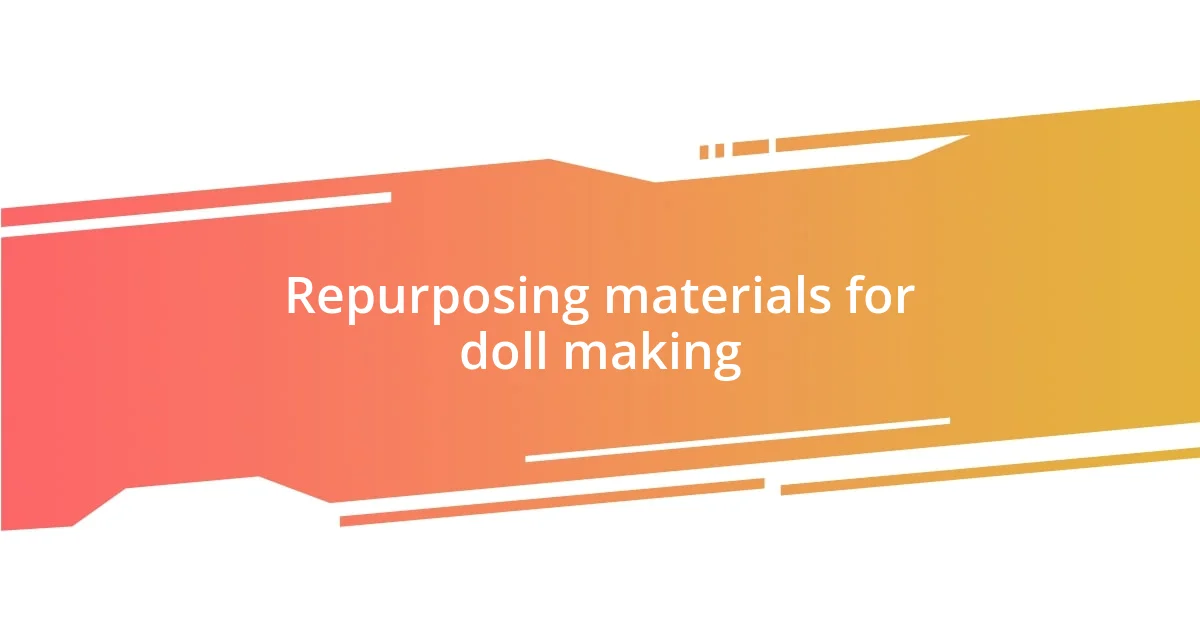
Repurposing materials for doll making
When it comes to repurposing materials for doll making, I often find inspiration in everyday objects, giving new life to items that might otherwise end up in the trash. Take, for instance, old clothing—those beloved sweaters or dresses can be transformed into cozy doll outfits. I remember the first time I used a faded flannel shirt of mine; it felt rewarding to see it reimagined as a charming dress. Isn’t it satisfying to know that we can breathe new life into something with sentimental value?
Another great source of inspiration has been leftover fabrics from friends or family who love sewing. I’ll never forget the day my grandmother gifted me a box of scraps. Each piece contained stories waiting to be told. I started stitching bits together, and it became a beautiful patchwork that not only celebrated my family’s history but also highlighted the beauty of repurposed materials. Have you ever thought about the tales that could be woven into an item before it’s thrown away?
Lastly, I’ve discovered that using discarded buttons can add a unique flair to my dolls. I have a jar filled with vintage buttons, and dipping into it is like exploring a treasure chest from the past. The first time I sewed some onto a doll’s dress, it gave the outfit an unexpected charm that made me smile. There’s something magical about adding personal touches that reflect not just sustainability but also creativity—don’t you think that’s what crafting is all about?










